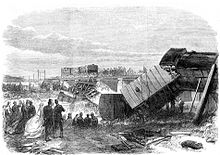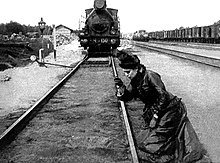List of railway accidents as a literary subject
The list of railway accidents as a literary topic contains a chronological listing of railway accidents that have been literarily processed or gave a corresponding impetus.
Real accidents
The Straffan , Ireland , railway accident on October 5, 1853 was described by William Allingham in a poem , The magic car of modern skill , published in his collection of poems Day and Night Songs the year after the accident .
In the railway accident in the Clayton Tunnel , England , on August 25, 1861 , a passenger train collided with a backing special train in the Clayton Tunnel - 7 km north of Brighton . 23 people died and around 176 were injured, most of them seriously. The tunnel was secured with a block signal in front of every portal that was operated by the train crew or a guard. The accident was edited by Charles Dickens in the short story The Signal-Man , a ghost story about a railroad accident.
In the railway accident in Staplehurst , England, on June 9, 1865, a train coming from Folkestone to London derailed on the bridge over the Bump , a tributary of the Medway , because tracks had been removed here due to construction work on the South Eastern Main Line and the safety device the construction site failed. 10 travelers died in the accident and 40 were injured. One of the passengers on the train was the writer Charles Dickens . He then wrote the short story The Signal-Man , the content of which, however, refers to the railway accident in the Clayton Tunnel . The Staplehurst railway accident was also processed in the plot of Ronald Frederick Delderfield's " God is an Englishman " (Swann Saga) and the accident is the starting point of the novel Drood from 2009 by Dan Simmons .
The railway accident on the Firth-of-Tay Bridge on December 28, 1879 went hand in hand with the collapse of the three-kilometer Firth-of-Tay Bridge in a hurricane when a train was passing through it. Its 72 travelers and railway employees were killed. Theodor Fontane addressed the event in his ballad Die Brück 'am Tay , William McGonagall also wrote a poem The Tay Bridge Disaster in 1880 , and Max Eyth dealt with the accident in his 1899 short story The Bridge across the Ennobucht.
The Honey Creek railway accident on July 6, 1881 was largely prevented by the then 17-year-old Kate Shelley (1865–1912): after a locomotive had crossed the bridge over the Des Moines River collapsed - two deaths were the result - warned Under dramatic circumstances and at the risk of her life, she caught an express train with 200 passengers in time, which drove to the destroyed bridge. With this act, Kate Shelley and the (prevented) railroad disaster went down in American folklore.
The railway accident of the Old 97 in Danville occurred on September 27, 1903 when the train 97 of the Southern Railway , called "Old 97", derailed due to excessive speed when approaching a bridge. According to various sources, nine or eleven people died, including the locomotive crew and postal workers in a mail car behind the locomotive. The accident inspired the country song " Wreck of the Old 97 ".
The Regenstauf railway accident was a relatively minor rear-end collision between the Munich – Berlin night train (D 21) on May 1, 1906 near Regenstauf : a wrongly set point hit a freight train that it was supposed to overtake. A prominent passenger on the train was Thomas Mann , who dealt with the events in the story The Railway Accident - published in 1909.
The railway accident in the Kaiser Wilhelm Tunnel on November 22, 1948 was triggered by a coal dust explosion that set the driver's cab of a steam locomotive on fire. The accident became very well known thanks to the deliberate action taken by the engine driver , August Vochtel , who averted a disaster . Both the French military governor Marie-Pierre Kœnig and Federal President Theodor Heuss honored him for his heroic deed. It was processed several times in short stories and school books.
The Abenheim railway accident is the central event of a graphic novel that was developed by Nina Beier as part of a bachelor thesis and is to be detailed in her master’s thesis .
In the short story The Railway Accident , Rudolf Hagelstange reports on the indirect consequences of a railway accident, the resulting delay and its consequences, including his meeting with Max Bense .
Fictitious accidents
- 1877
In his novel Anna Karenina (1877), Leo Tolstoy lets the eponymous heroine end up suicide in front of a train.
- 1890
Emile Zola describes in his novel Die Bestie im Menschen (French: La Bête Humaine ), published in 1890 , also under the title Das Tier im Menschen, a railway accident deliberately caused out of jealousy. A train drives at high speed into a carriage parked across a level crossing . The accident claims numerous dead and injured.
- 1907
In the story the last express train wagon of William Shepherd is a double railway accident, the framework: The train first be converted to a horse and comes to a halt. While the travelers are relieved that the incident ended so smoothly, a second train collides with the stationary train and smashes the last car.
- 1916
Paul Ernst presents in his novel The wife of the flagman a turnout guards before the decision an approaching train derail either to let or allow the train passes over the child. He decides to become a civil servant and his child dies. That makes his marriage fail.
- 1922
Paul Ernst tells of the psychic experiences of a wife who loses her husband in a railroad accident.
- 1933
Joseph Roth reports in station boss Fallmerayer about a railway accident as part of a love story that is partly set in the railway environment.
- 1936
In Ödön von Horváth's play The Youngest Day , a station master lets himself be distracted by a girl, which means that a signal is set too late and two trains collide. The result is seventeen deaths. The opera The Youngest Day by Giselher Klebe ( premiered in Mannheim 1980) is based on Horváth's play .
- 1952
In his short story Der Tunnel, Friedrich Dürrenmatt uses a ( surrealistic ) railroad accident as a metaphor to portray the hopelessness of a situation in which the inevitable catastrophe is approaching the travelers who, however, mostly do not want to perceive it.
- 1963
In Alexander Isayevich Solzhenitsyn's metaphor-rich tale Matrjonas Hof , the life of the maternal peasant woman Matrjona comes to an abrupt tragic end as she crosses an unrestricted level crossing under the wheels of an approaching train.
- before 1980
In her novel The Derailment, Inge von Wangenheim derails the last wagon of a freight train in a small Thuringian town, which is damaged in the process and loses its load. These loads are pornography printed in the GDR, intended for export to Sweden, which is now being distributed under the roof and in the town, causing quite a stir.
- 2017 (1889)
In the children's book With the Orient Express to Paris , a train journey from Constantinople to Paris in 1889 is described and a criminal case is solved. In the station Simbach (Inn) there is a boiler explosion of locomotive of the train, which caused delay and are the main players extra time to resolve the criminal case.
See also
- Railway accident
- List of serious accidents in rail transport
- List of attacks in rail transport
- Kettle crack
- Navigation bar lists of railway accidents
literature
- Rolf Füllmann: Railway accidents. Technology as fate on rails in novellas by Wilhelm Schäfer, Paul Ernst and Thomas Mann . In: Inklings. Yearbook for Literature and Aesthetics 25 (2007), pp. 185–211.
- Karl R. Kegler: Suffering - understanding - telling. Fictional technical disasters and the non-simultaneity of knowledge and ignorance . In: Inklings. Yearbook for Literature and Aesthetics 25 (2007), pp. 58–91.
Remarks
- ↑ The author was on a train that drove behind the accident train and was therefore diverted. His information on the accident situation remains vague: "In the mid-fifties", "in Württemberg " and he was sitting in an express train going to Stuttgart main station .
- ↑ First published in 1952 in the anthology Die Stadt. Prose I – IV appeared, later in further, modified versions.
Individual evidence
- ^ William Allingham: Day and Night Songs. G. Routledge & Co. London 1854; the text is reproduced in the parallel article in the English language Wikipedia .
- ↑ First published in the collection Mugby Junction the Christmas issue of the magazine All the Year Round . 1866
- ↑ 1970; German : God is English (1972).
- ↑ Ders .: Gedichte I. 2nd ed. 1995 (Grosse Brandenburger Edition), pp. 153–155.
- ^ William Topaz McGonagall: The Tay Bridge Disaster
- ↑ Max Eyth: The bridge over the Ennobucht in the Gutenberg-DE project . See: Kegler, pp. 69ff.
- ↑ See: John Brayshaw Kaye : Our Kate. In: Songs of Lake Geneva and other poems. New York 1882.
- ↑ Mark Meinold: The engine driver of the Prussian State Railway 1880-1914. Hövelhof 2008, ISBN 978-3-937189-40-6 , p. 170.
- ↑ Thomas Mann: The railway accident. In: The Stories. German paperback publisher. Frankfurt 1986, pp. 462-473; see. on this: Füllmann, p. 202ff.
- ↑ For example: Alwin Mortzfeld, Kurt Siebrandt: Train driver Vochtel fights against death . In: It's about minutes. From selfless acts of salvation . Verlag Ensslin & Laiblin, Reutlingen 1952. (Small Ensslin books, no. 21).
- ↑ Ulrike Schäfer: The misfortune that shook Worms . In: Wormser Zeitung of July 24, 2020, p. 11.
- ↑ Rudolf Hagelstange: The railway accident . In: Railway stories with a kick. Munich 1985. ISBN 3-471-77865-9 , pp. 127-131.
- ^ Wilhelm Schäfer: Hundred Histörchen . Munich 1940; see: Füllmann, p. 195ff.
- ↑ Paul Ernst: The railwayman's wife . In: Stories of German Art. Munich 1928, pp. 70–75; see: Füllmann, p. 194f.
- ↑ Paul Ernst: The railway accident . In: Stories Between Dream and Day. Munich 1930, pp. 116-121; see: Füllmann, p. 187ff.
- ↑ Inge von Wangenheim: The derailment . Central German publisher. Halle / Leipzig 1980.
- ^ Stephan Martin Meyer and Thorwald Spangenberg: With the Orient Express to Paris . Gerstenberg, Hildesheim 2017. ISBN 978-3-8369-5985-8

